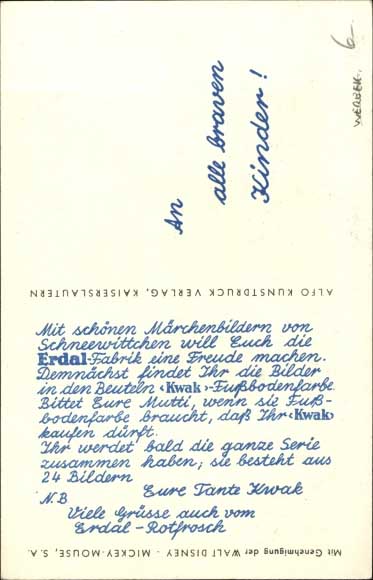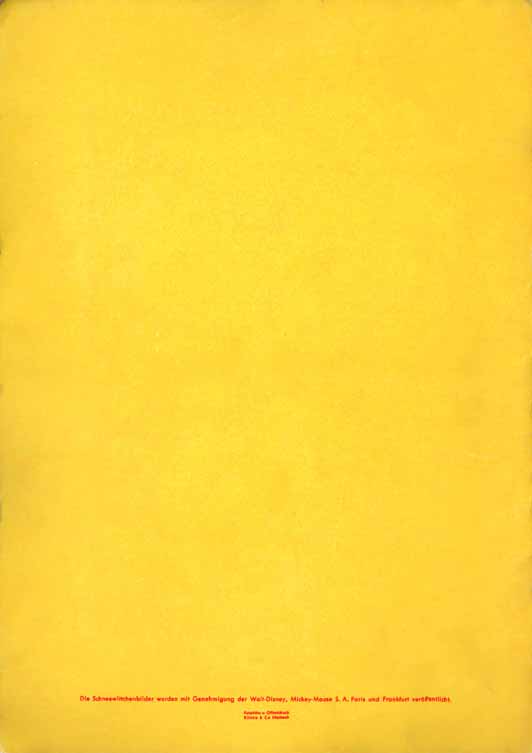Information
Complete title: Erdal Rotfrosch altbewährt bringt für die Fleißigen Kinder das schöne Marchen von Schneewittchen und den sieben Zwergen nach dem berühmten Farbfilm von Walt Disney (Erdal Red Frog Proven brings to studious children the lovely tale of Snow White and the Seven Dwarfs, based on the famous color film by Walt Disney)
Author: Philipp Mühlen & Co. GmbH in Völklingen, Saarland
Illustrations: unknown
Publication Date: 1950
Publishers: Werner & Merz
Country: Germany
Retail price: FF70
Dimensions: 8” x 3.2”
Number of pages: 16
Back to German Books
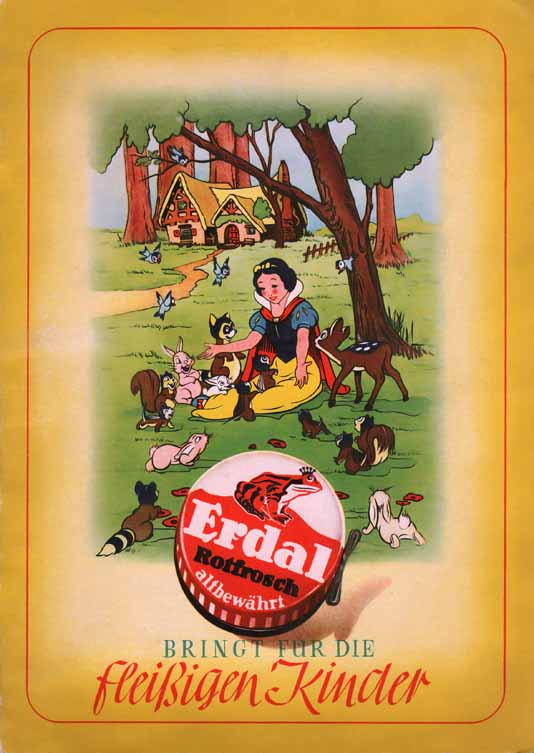
This 8×3.2” advertising album created for the Werner & Merz company in Mainz, Germany, was designed by Philipp Mühlen & Co. GmbH in Völklingen, Saarland, to jointly promote the film Snow White and the Seven Dwarfs, but above all the firm’s products, such as Erdal shoe polish, a tin of which is reproduced on the cover. The logo, a red frog, was created in 1902 and has been used in various forms ever since. At the bottom of each page is a slogan extolling the benefits of this shoe polish and other products such as Waxa polish and Kwak floor paint.
The album has sixteen pages. In addition to the title page and the last two pages, twenty-four postcard-sized images had to be glued in place to visually reconstruct the story of the film, which is summarized on the last two pages, with the numbers of the cards in brackets placed at the corresponding points in the story.
The title, which appears only on the title page and not on the cover, is “Das schöne Marchen von Schneewittchen und den sieben Zwergen”, which translates “The Beautiful Fairy Tale of Snow White and the Seven Dwarfs“.
Apart from the small summary below the picture, which is in German, the illustrations are exactly the same as those on the French Séphériadès cards. However, as the latter only featured illustrations of the happy moments in the film, it was necessary here to add three more cards to illustrate the crucial moments that are essential to understanding the story. It seems that these illustrations of the Queen, the Witch and the coffin were done in the same style as the previous ones, but probably by a different hand. In one of them, Snow White’s dress turns from yellow to pink.
The back cover states that the Snow White illustrations are the property of Mickey-Mouse S.A. Paris and Frankfurt, and that the album and photogravures were printed by Klinke & Co Mettlach.
It’s the reproduction of the shoe polish box that makes it possible to date the album. It features a small lever for easy opening, an invention dating back to 1948. As the frog doesn’t yet have the characteristic smile it’ll be sporting from 1962 onwards, it’s very likely that this album dates from the film’s release in Germany, in 1950.
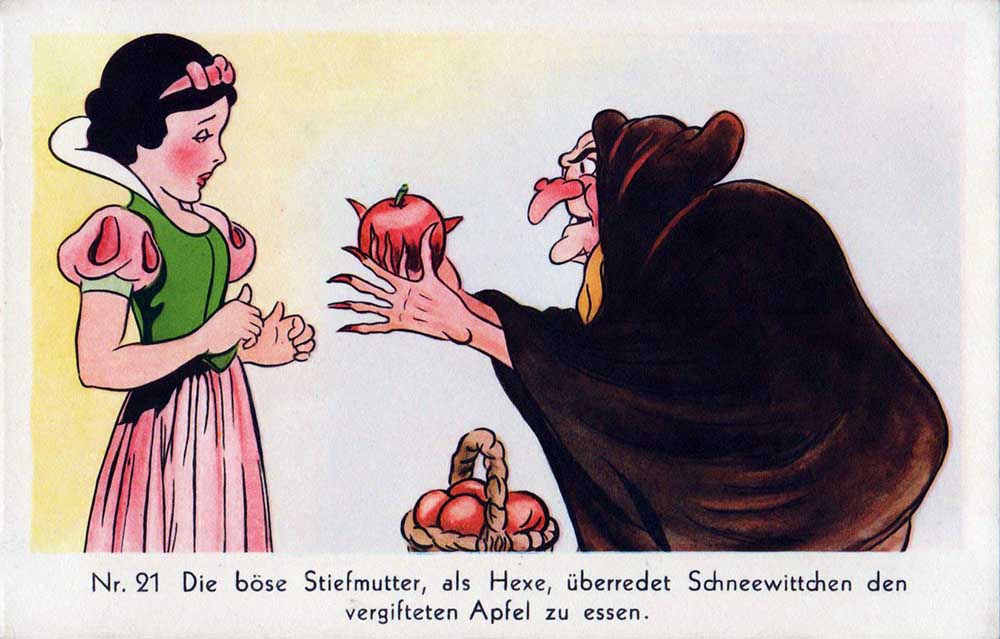
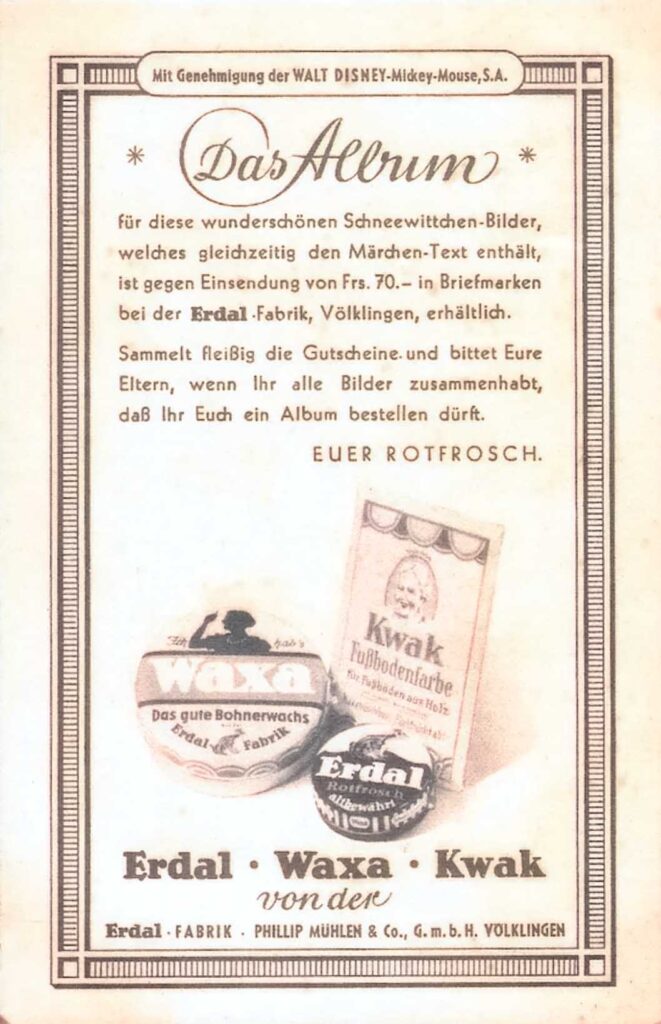
The back of the postcards contains a text explaining the procedure to be followed: “The album of these beautiful illustrations of Snow White, which also contains the text of the fairy tale, is available for 70 Frs. in stamps from the Erdal factory in Völklingen. Collect the vouchers and ask your parents to order the album for you once you’ve collected all the images. Signed: your red frog.”
After the Second World War, the Saar region was placed under French supervision from 1947 to 1956. Hence, the album would be available in francs. Erdal also had its French head office in Paris, at 15 rue Richard Lenoir, and its products were distributed in France.
There are postcards with the same illustrations, but with a different text on the reverse. They seem to have been distributed before those in the album, and are marked “Alfo Kunstdruck Verlag, Kaiserlautern”. The text, printed as if in pen and ink, reads: “Erdal wishes to delight you with beautiful images of Snow White. Soon you’ll be able to find them in Kwak floor paint packs. Ask your mother to buy some Kwak. You’ll soon have the whole series of twenty-four images. Signed: your Aunt Kwak.”
So it seems that the cards are indeed in the brand’s products.
If you have an explanation for the mystery of the francs, drop me a line.
